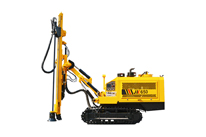Eight systems that a rig must have
Drilling rig is a general term for a full set of drilling equipment. At present, the most widely used rotary rig in the world. The hydraulic drilling rig consists of a diesel engine, a transmission shaft, a drilling pump, a winch, a derrick, a crane, a traveling crane, a hook, a faucet and a turntable.
According to the requirements of the drilling process, well cleaning, and drilling tools in the drilling process, a set of rigs must have the following eight systems and equipment.
(1) Lifting system. In order to lower the drilling tool, the casing, and control the drilling of the drill bit, the drilling rig must have a set of lifting mechanisms. It mainly includes main winches, auxiliary winches (or cat heads), auxiliary brakes (water brakes, electromagnetic brakes, etc.), swimming systems (including wire ropes, cranes, cruises, and hooks), and derricks that suspend the swimming system. In addition, there are tools and equipment (lifting rings, elevators, tongs, slips, standing root moving mechanisms, etc.) used for lifting and lowering operations.
(2) Rotating system. In order to rotate the drilling tool to continuously break the rock, the water well drilling rig is equipped with a turntable or a power faucet, a drill string and a drill bit are provided underground, and some use a underground power drilling tool.
(3) The circulatory system. In order to remove the broken rock with drilling fluid at any time to ensure continuous drilling, the drilling rig is equipped with a drilling fluid circulation system. The circulation system includes drilling pumps, surface manifolds, drilling pool fluids and drilling fluid tanks, drilling fluid purification equipment, and equipment for preparing drilling fluids. In jet drilling and downhole power drilling, the circulation system is also responsible for transmitting power.
(4) Power system. The power equipment driving the working units such as winches, drilling pumps and turntables can be diesel engines, AC motors or DC motors, or gas turbines.
DTH Drilling Rig
(5) Transmission system. The main task of the transmission system is to transfer and distribute the mechanical energy of power equipment to working machines such as winches, drilling pumps and turntables. The output characteristics of power equipment often cannot meet the needs of the working machine, so the transmission system is required to have a variety of performances such as deceleration, parallel and reverse while transmitting and distributing power. The transmission methods of petroleum rigs are: mechanical transmission (including universal shaft, reduction gearbox, clutch, chain transmission and V-belt transmission, etc.), mechanical-turbine transmission (hydraulic transmission), electric transmission and hydraulic transmission.
(6) Control system. In order to make the various systems of the rig work in coordination, the rig is equipped with various control equipment such as mechanical control, gas control, electric control and hydraulic control, so as to centralize the gas console and observation and recording instruments.
(7) The base. Including drilling machinery base, machine room base and drilling pump base. The base of a truck-mounted rig is the chassis of a car or tractor.
(8) Auxiliary equipment. Auxiliary equipment (ancillary equipment) generally includes air compressors, rat hole drilling equipment, wellhead blowout prevention equipment, auxiliary power generation equipment (for mechanized devices, air compressors and lighting electricity), auxiliary lifting equipment, living houses (material warehouse, Repair room, duty room, etc.). When drilling in cold areas, heating and insulation equipment is also required.

评论
发表评论